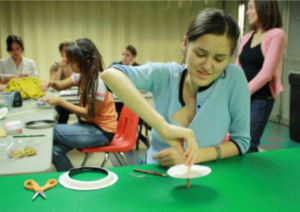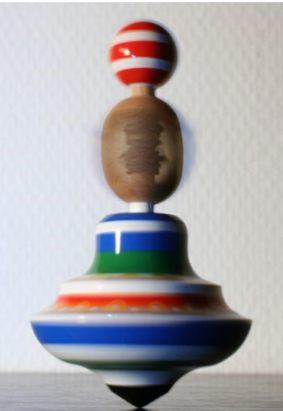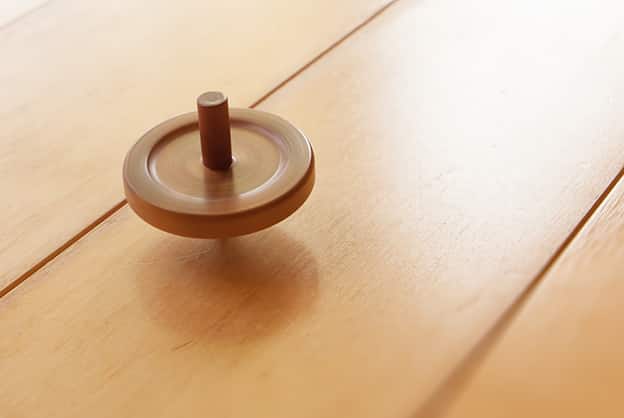Overview
STEM careers
Time
Materials
Supplies & Equipment:
 Making a top with a paper plate and a pencil. Credit: Austin Children’s Museum. |
Consumables:
|
Relevant Terminology
Angular acceleration: How much faster or slower a top is spinning over time. (For older participants: The change in an object’s angular velocity over time.)
Angular momentum: How likely something is to keep spinning. If it’s spinning really fast, it has more angular momentum than if it’s spinning slowly. (For older participants: An object’s angular momentum results from its angular velocity and the way its mass is distributed.)
Angular velocity: How many times per second an object spins. A car tire spinning 100 times each minute has twice as much angular velocity as the same tire spinning 50 times per minute.
Gyroscopic effect: When tops are spinning, they resist spinning in a different direction. This is the gyroscopic effect—the tendency of a spinning wheel to resist a change in its orientation.
Momentum: The amount of mass in motion. An object’s momentum depends on how much matter (its mass) is moving and how fast it’s moving. A boulder speeding down a mountain has much more momentum than a marble rolling slowly across the floor, and would require much more energy to stop it. (For older participants: momentum is the product of an object’s mass and its velocity.)
Introduce
GETTING READY
If using hot glue, set up the glue guns first so that they have time to heat up. Depending on the age of the children doing the activity, you may choose to substitute double-sided tape for hot glue to avoid the potential for burns. Decide in advance if you want to provide several different options for building tops or limit the materials.
INTRODUCTION
Gyroscopes are the key to making everything from airplanes and Segways to virtual reality goggles work. How?
The gyroscope effect is the tendency of a spinning object to keep its original orientation. Spinning objects have angular momentum. This means that it takes a force to change the speed or the axis of the spin. Angular momentum depends on how fast the object is spinning and how its weight is distributed. Engineers apply this principle in many ways. Aerospace engineers need to consider angular momentum when designing satellites.
When you spin a top fast, it has a lot of angular momentum. This makes the top stable. The greater the angular momentum, the longer the top will spin. Like regular momentum, angular momentum can be increased by increasing the mass of the top (especially in certain locations) and by increasing how quickly it is spinning. Friction between the top and the air and surface on which it is spinning eventually causes the top to slow down and lose its angular momentum. This is when it begins to wobble and, ultimately, fall over.
Instructions

Spinning tops have delighted children for thousands of years. Credit: Philippe Teuwen.
Ask participants about when they have spun tops in the past and ways they tried to get them to spin for as long as possible.
Introduce the design challenge. Encourage participants to build a spinning top that remains stable and spinning for the longest possible time.
Guide participants in building their tops. Each top will need a disk and a spin axis. You can try different combinations (shown listed below) to see how they work. You can also attach a bottle cap with a hole to the center of the top, and push the skewer or pencil through to provide a convenient place to spin the top.
- Paper plate & wooden skewer
- Cardboard circle & pencil
- CD & glass marble
Have participants test their top by giving it a spin.
Encourage them to take note of the plane of the disk. Is it horizontal? Does it wobble, or is it stable? If it wobbles, use questions to help the builder determine the cause.
Encourage them to make adjustments to their top and try again. Time how long it takes the top to wobble and hit the table. Participants can continue making adjustments while trying to beat their best time.
Evaluate the success of each design:
- Did the top spin?
- Was the top stable, or did it wobble?
- How long did it spin before losing stability?
ACTIVITY VARIATIONS
- Make the top out of cardboard circles of various diameters. Which one spins the longest?
- Build battle tops. Pit two tops against each other, and observe what happens when they collide. Which one wins?
- Relate the activity to museum exhibits that deal with rotational motion of satellites, gyroscopes, figure skaters, and so forth.
- Younger children may want to decorate their tops. Think about supplying markers, ribbons, or other craft supplies.
TROUBLESHOOTING
The most likely cause of an unstable top is that the rotational axis is not aligned with the center of mass. There are two likely causes for this:
- The pencil or skewer is not centered on the disk, or
- Weights that have been added to the disk were not distributed evenly, resulting in a top that is out of balance.
Guiding questions
GUIDANCE FOR YOUNGER CHILDREN
QUESTIONS TO ASK AFTER THE ACTIVITY
-
What could you do to make your spinning top more stable (wobble less)?
-
How long did your spinning top spin before starting to wobble?
-
How could you make your spinning top spin faster? Longer?
-
Do you think it is more important that your top spin faster or be heavier to spin as long as possible?
GUIDANCE FOR OLDER YOUTH AND ADULTS
QUESTIONS TO ASK AFTER THE ACTIVITY
- Were you able to get your spinning top to stand upright or almost in a vertical position?
- If your spinning top was unstable, what did you do to stabilize it?
- Did you experiment with changing the position of the disk? If so, what position seemed to work the best?
- How can you increase the angular momentum of your spinning top?
- If you added mass to your spinning top, where did you add the mass and why?
- Identify two ways that you could reduce the friction acting on your spinning top.
Engineering & science connections
GUIDANCE FOR YOUNGER CHILDREN
Engineering Connections
Spinning tops have been around for thousands of years and have been used for entertainment, gambling, and even spiritual purposes.
Today, engineers use the principles of spinning tops in gyroscopes that help common machines including airplanes and Segways function. Gyroscopes are built of spinning tops where the end points are connected to an axle like the tires on your bike. Once a gyroscope is spinning, it does not easily change its position or orientation. Due to the gyroscope’s tendency to keep its original orientation, they have a number of different uses including computer pointers, racing cars, and virtual reality goggles. There are currently computer pointers on the market that use gyroscopes so that the mouse cursor can control the computer while in the air by tracking the movements of your hand and translating those movements into cursor movements.
Science Connections
A spinning top contains four basic parts: the point, the body, the shoulder, and the crown. Once a spinning top starts to spin, the top remains upright until it loses energy from the sliding friction caused by the point moving across a surface. The top stays upright, for the most part, because of something called the gyroscopic effect.
You can see the gyroscopic effect in action by using a bicycle wheel. Hold both ends of a bicycle axle in each hand, hold the bicycle wheel in a vertical position, and have a friend spin the wheel. If you try to push the wheel forward with your right hand, instead of the wheel turning to the left, you will see the top of the wheel tilt to the right. It is this gyroscopic effect that keeps you upright while riding a bicycle. When turning a corner on a bicycle, the bicycle naturally wants to go in the same direction that you are turning. When turning to the left, the reason you don’t tip over when you tip the wheel to the left is because the gyroscopic effect on the front wheel is pushing the top of the wheel in the opposite direction. The exact opposite happens when you turn to the right.
GUIDANCE FOR OLDER YOUTH AND ADULTS
Engineering Connections
A gyroscope is a type of spinning top with a wheel connected to an axle that spins when a force or torque is applied to it. As the gyroscope spins, it resists any change in the orientation of the rotating wheel. The fact that gyroscopes resist a change in their orientation makes them rather useful in inertial navigation systems. Inertial navigation systems are made up of a computer, sensors that measure acceleration, and gyroscopes that work together to control the velocity, position, and orientation of aircraft, ships, submarines, or spacecraft. They help to keep an aircraft or other vehicle upright and oriented in the way desired by the pilot.
Science Connections
To understand how a spinning top works, we must first understand what angular momentum is and how angular momentum can be changed using torque. A simple way to think about angular momentum is that it depends on how much mass a rotating object has and how fast it is spinning. The more massive the object, the greater its angular momentum. Similarly, the faster something rotates, defined as the number of rotations per second, the greater its angular momentum. Torque is force acting at a distance from the axis of rotation that causes the object to rotate.
If a spinning top is spun perfectly upright so that the axis on which it rotates is perfectly centered, gravity cannot apply a torque on the spinning top, so the only forces that would be acting to stop the spinning top are forces of friction (where the top sits on the surface it is spinning on) and air resistance. In reality, however, the center of mass is never located perfectly through the rotational axis. This can eventually be observed when a spinning top begins to wobble as it starts to slow down.
Activity adapted from Cincinnati Museum Center. All rights reserved.
Supplemental content adapted for Dream Big Activities by Carnegie Science Center.


0 Comments